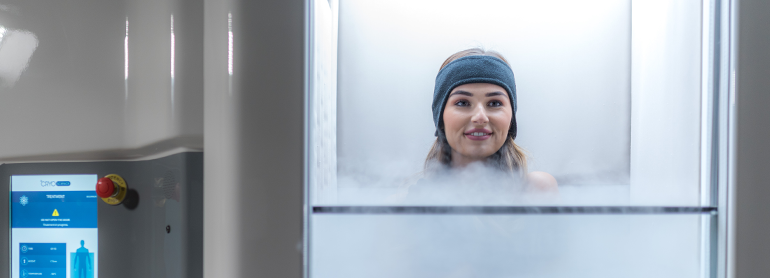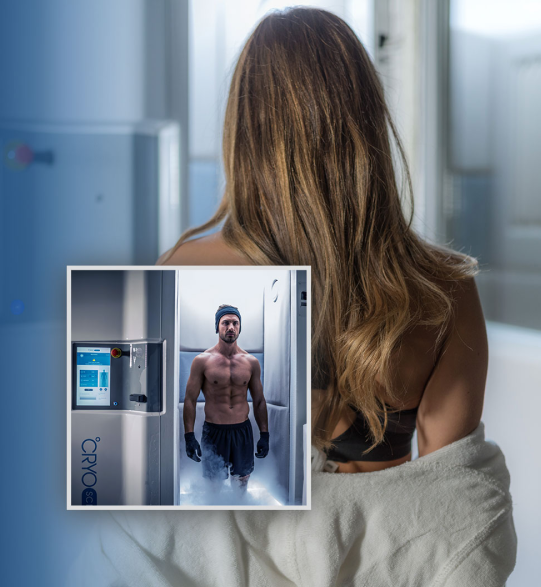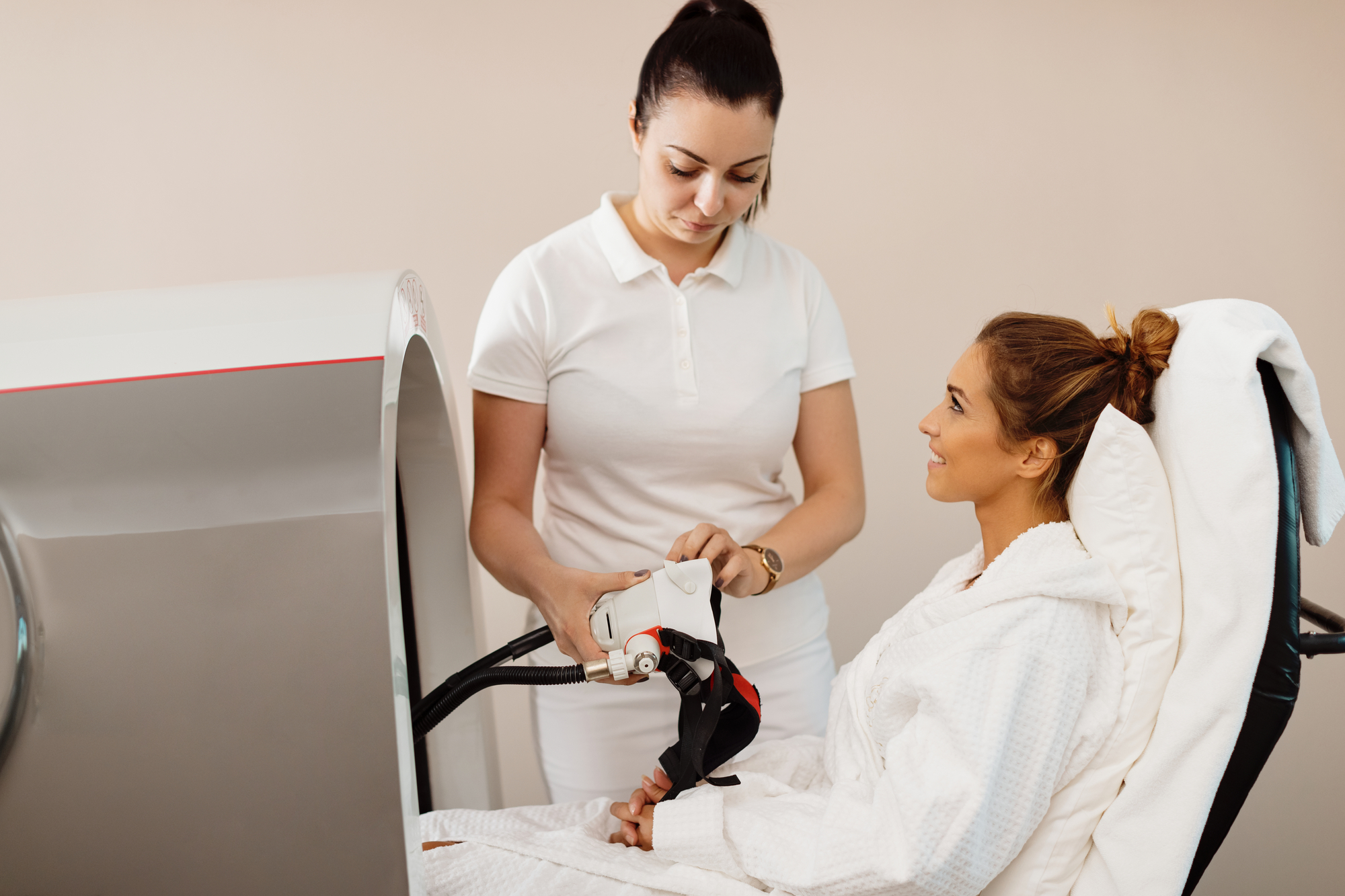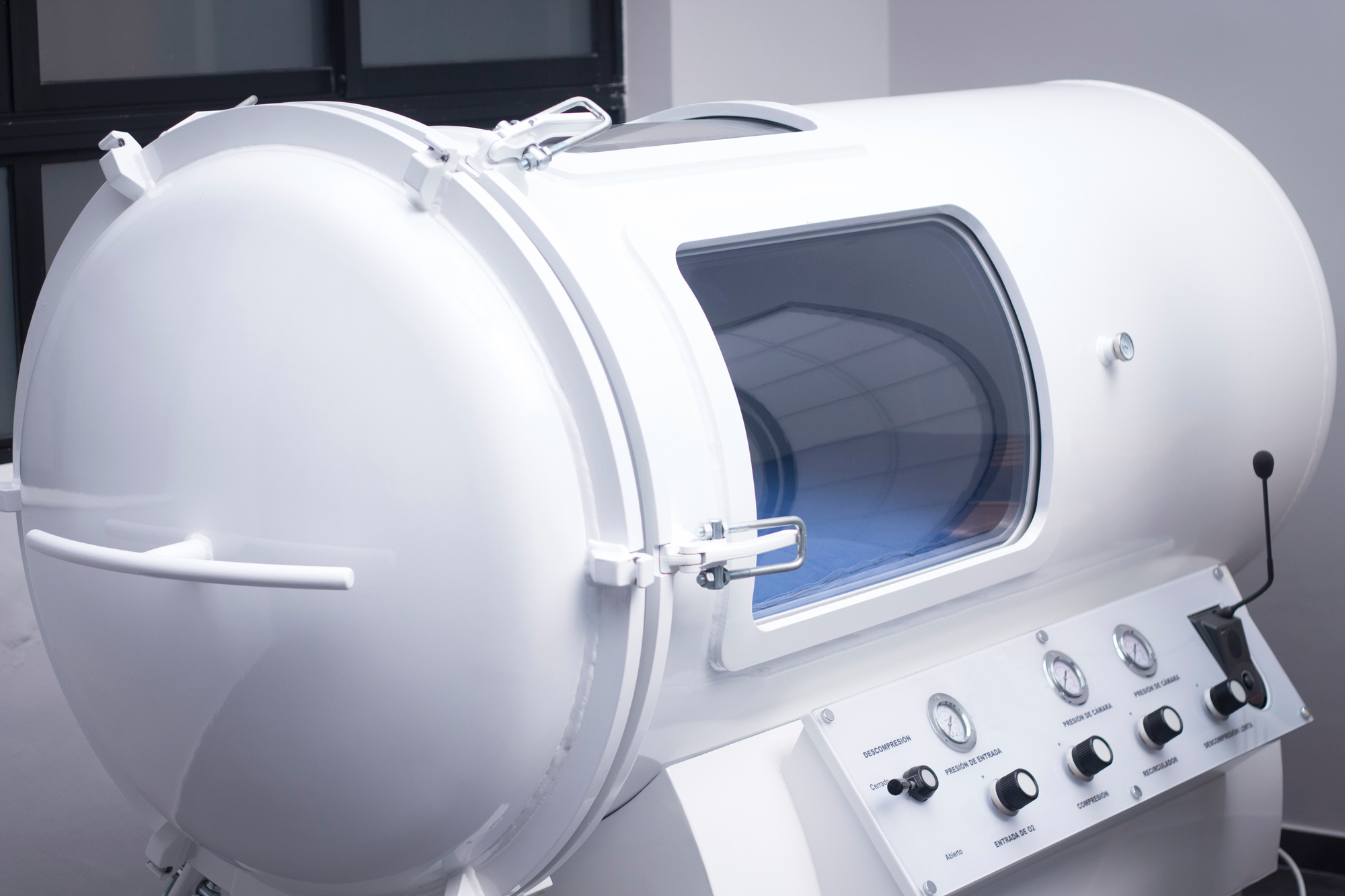Use of Nitrogen
Cryotherapy often uses liquid nitrogen, a colorless and odorless gas, as a quick and effective way to cool the body or specific areas. In whole-body and localized treatments, liquid nitrogen is turned into a cold mist, creating a chilly environment that helps soothe pain, reduce swelling, and speed up muscle recovery.
This method cools the skin rapidly, triggering the body’s natural healing processes without the discomfort of traditional ice methods. It’s a quick and efficient way to benefit from cold therapy, making it a popular choice for those looking to alleviate discomfort and improve their well-being.
Cryotherapy Chamber or Whole-Body Cryotherapy
The cryotherapy chamber, also known as whole-body cryotherapy, involves stepping into a specialized chamber where your entire body is exposed to extremely cold temperatures. Typically, this lasts for a brief period, between two to four minutes.
This exposure is achieved through the cooling effects of nitrogen or refrigerated cold air, creating an environment that can drop to as low as -166 to 220°F. This intense cold stimulates the body’s physiological responses, including reducing inflammation, releasing endorphins, and increasing blood circulation, providing benefits beyond localized treatment areas.
Target Cryotherapy or Partial-Body Cryotherapy
Target cryotherapy, or partial-body cryotherapy, focuses on treating specific areas of the body, such as a sore knee, an aching back, or an injured shoulder. Unlike whole-body cryotherapy, which exposes the entire body to cold temperatures, targeted treatments use devices that direct cold air or liquid nitrogen to the affected area.
This localized approach allows for precise temperature control, ensuring the therapeutic cold reaches deep into the tissues to reduce inflammation, alleviate pain, and speed up recovery. It’s especially beneficial for athletes and people with localized injuries, helping to quickly address problem areas without subjecting the entire body to extreme cold.
Ice Bath or Cold-Water Therapy
Ice bath or cold-water therapy is a traditional form of cryotherapy where you immerse yourself in cold water, typically ranging from 35°F to 59°F, for a set period, often between 10 to 20 minutes. This method is popular among athletes for its effectiveness in reducing muscle soreness and accelerating recovery after intense physical activity.
The cold water causes blood vessels to constrict, decreasing blood flow to reduce inflammation and tissue breakdown. Upon exiting the bath, blood vessels dilate, flushing out metabolic waste from muscle tissues and bringing fresh, oxygen-rich blood. Ice baths aid in physical recovery and can help improve physical and mental health by building tolerance and strength in uncomfortable conditions.
Ice Application
Ice application is a targeted form of cryotherapy where ice packs or cold compresses are applied directly to the skin’s surface on injured or painful areas of the body. This method is widely used for its simplicity and effectiveness in managing acute injuries, reducing swelling, and alleviating pain.
By applying cold directly to the affected area, ice helps constrict blood vessels, limiting blood flow and inflammation and numbing nerve endings to provide immediate pain relief. The convenience of ice application makes it a go-to choice for immediate post-injury care and for treating chronic conditions like tendonitis or arthritis at home or in a clinical cryotherapy setting.
The Science Behind Cryotherapy
The scientific basis of cryotherapy lies in its ability to trigger physiological and biochemical responses in the body, primarily through exposure to extreme cold. The following are a few of these processes and how they help achieve the benefits of cryotherapy:
- Vasoconstriction and vasodilation. Exposure to cold leads to vasoconstriction, where blood vessels in the skin and peripheral tissues narrow, reducing blood flow and swelling in inflamed areas. Following this, vasodilation occurs as the body warms up, expanding blood vessels to increase circulation. This rush of oxygen-rich blood to tissues aids in faster muscle recovery and removes exercise-induced metabolic waste.
- Pain relief through nerve activity reduction. The cold temperatures of cryotherapy act on nerve endings to reduce their activity, temporarily dulling pain signals sent to the brain. This numbing effect provides immediate relief from discomfort, making it effective for acute and chronic pain management.
- Increased metabolic rate via thermogenesis. The body responds to the cold by increasing its metabolic rate, a process called thermogenesis, to generate heat and maintain a stable internal temperature. This accelerated metabolism results in higher calorie burn, supporting weight management efforts.
- Activation of brown fat. Cryotherapy stimulates brown adipose tissue (BAT), a type of fat that generates heat in response to cold. BAT activation through cold exposure enhances the body’s ability to burn calories and produce heat, contributing further to metabolic benefits.
- Endorphin release and stress reduction. The extreme cold triggers the release of endorphins, known as feel-good hormones, due to the body’s stress response to the cold exposure. These hormones elevate mood, create a sense of well-being, and act as natural pain relievers. The endorphin release can lead to reduced stress levels, improved mood, and better sleep patterns, boosting mental health.
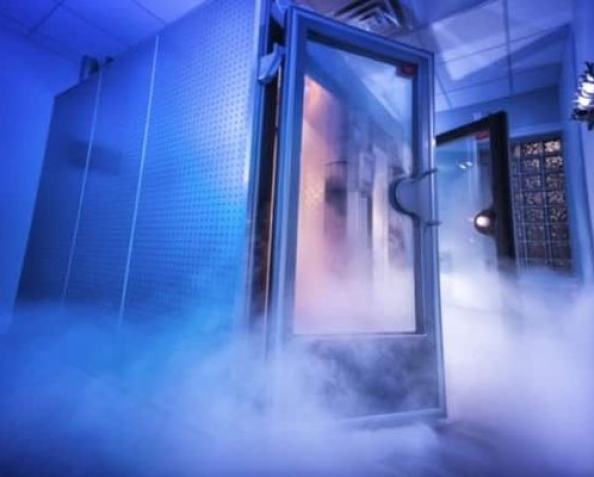
The Benefits of a Good Cryotherapy Session for Patients
A cryotherapy session can offer a range of therapeutic benefits for patients, harnessing the power of extreme cold to improve well-being. This innovative treatment method can help address the following health issues and skin conditions:
Pain Relief
Cryotherapy reduces inflammation and numbs pain by decreasing the temperature of the affected areas. It is especially beneficial for arthritis, fibromyalgia, and post-surgical recovery.
A 2021 review found that local and non-local cryotherapy applications helped reduce pain in patients with chronic conditions. The cold exposure temporarily reduces nerve activity, relieving chronic and acute pain.
Muscle Recovery
Cryotherapy accelerates the healing process for athletes and physically active individuals by reducing muscle soreness and inflammation. The cold stimulates blood circulation, flushing away metabolic waste and bringing oxygen and nutrients to the muscles, which helps in faster recovery.
A 2021 study found that localized cold therapy to reduce muscle temperature after a workout can prevent tissue damage and help recovery.
Improved Skin, Hair, & Nails
Regular cryotherapy sessions can improve the appearance of skin, hair, and nails by increasing blood flow and stimulating collagen production. A 2015 study found that 91% of participants saw diminished forehead wrinkles after focused cold therapy.
The therapy can lead to tighter skin, reduced signs of aging, and stronger hair and nails, contributing to a healthier and more youthful appearance.
Improve Sleep
Cryotherapy can help you achieve a more comfortable and restful sleep by reducing pain and muscle soreness. The cooling treatment lowers stress levels and promotes relaxation, leading to better quality sleep and improved daily functioning.
A 2019 study found that 3-minute whole-body cryotherapy improved sleep in active male participants after training.
Common Concerns or Myths About Cryotherapy
Despite cryotherapy’s growing popularity and effectiveness, you may have concerns or misconceptions about the practice. Here are a few myths about cryotherapy and the truth to help you decide if this treatment is right for you:
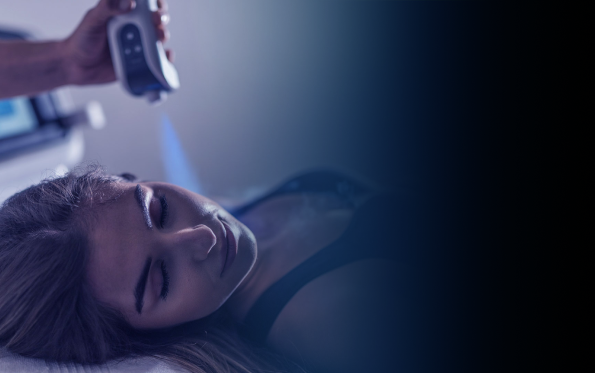
- Cryotherapy is extremely uncomfortable. While the sensation of extreme cold is noticeable, sessions are brief (under 4 minutes), and many report a refreshing or invigorating feeling afterward. Much preferable to the prolonged cold of ice baths or cold water immersion.
- Cryotherapy is only for athletes. Though popular among athletes for recovery, cryotherapy benefits extend to pain relief, inflammation reduction, and skin improvement, making it suitable for a wide audience.
- Cryotherapy poses major health risks. When conducted in a professional setting under detailed guidance, cryotherapy is safe. Facilities follow strict protocols to minimize risks, and sessions are adapted to individual needs and health conditions.
- Cryotherapy is just a trend with temporary popularity. The roots of using cold for therapeutic purposes trace back centuries. Modern cryotherapy’s growing popularity is backed by evolving scientific research and positive user testimonials, indicating its lasting impact on health and wellness.
- Cryotherapy sessions are time-consuming and inconvenient. Cryotherapy sessions are notably quick, typically lasting only 2-3 minutes, making them a convenient option for people with busy schedules looking for effective ways to enhance their health and recovery routines.
Which Type of Cryotherapy is Best for You?
If you’re ready to schedule your cryotherapy session but unsure which approach to use, comparing their uses and benefits is helpful. Here’s a quick reference to help you determine which session to book and where to do it:
| Type of Cryotherapy | Description | Benefits | Ideal For | Where to Get it Done |
| Whole-Body Cryotherapy (WBC) | Exposure to extremely cold air in a chamber for as little as 30 seconds or 2 minutes tops. | Reduces inflammation, enhances muscle recovery, releases endorphins. | Individuals seeking overall wellness, athletes, and those with chronic pain. | Specialized cryotherapy clinics or wellness centers like ReEnergized. |
| Localized Cryotherapy | Targeted cold air or liquid nitrogen applied to specific areas with spraying device or a cotton swab. | Precise pain relief, reduces swelling, and accelerates healing of localized injuries. | Targeting specific areas like joints, muscles, or certain skin conditions. | Cryotherapy clinics like ReEnergized, some physical therapy practices, and dermatologists for skin treatments. |
| Ice Bath or Cold-Water Immersion | Immersion in cold water, typically 50°F to 60°F, for 10-20 minutes. | Reduces muscle soreness, accelerates recovery post-exercise, and enhances mental toughness. | Athletes, fitness enthusiasts post-intense physical activity. | At home and sports facilities, or fitness centers. |
| Ice Bath or Cold-Water Immersion | Use of extreme cold to destroy abnormal or diseased tissue, including tumors inside the body. | Reduces muscle soreness, accelerates recovery post-exercise, and enhances mental toughness. | Treating skin lesions, certain cancers, and internal tumors. | Performed in healthcare settings such as hospitals, specialized clinics, and some dermatology offices. |
Preparing for a Cryotherapy Session
As you prepare for a cryotherapy session, there are a few steps to take to ensure a beneficial experience. Here’s what to consider:
A Step-by-Step of the Cryo Chamber Therapy Process
Knowing what to expect from your first cryo chamber experience can help you enjoy the session more fully. Here’s what you can expect for your cryotherapy appointment at ReEnergized:
Before you enter the cryo chamber, you’ll be guided through detailed instructions. Our team will show you how to position yourself inside the chamber, keep your breathing steady to manage the initial cold shock, and mentally prepare as the temperature rapidly decreases.
It’s natural to feel a brisk chill initially, but your body is remarkably adaptable. You’ll be advised to gently rotate at intervals for uniform cold exposure. This helps acclimate your body to the extreme cold and ensures that the therapeutic benefits are evenly distributed.
The staff will closely monitor you throughout, ready to assist or answer any questions, making sure you feel secure and informed from start to finish.
Cryotherapy chamber sessions typically last 2 to 3 minutes, with temperatures dropping to as low as -220°F for optimal therapeutic effect. At ReEnergized, the cryo chamber experience is tailored to individual preferences, featuring an adjustable window and temperature settings for a personalized comfort level.
You can choose from multiple protocol options to match your specific recovery needs. The chamber is equipped with customizable lighting themes and a Bluetooth sound system, enhancing the session with a personal touch.
These amenities combine to create a unique, immersive experience supporting your physical recovery and mental rejuvenation within an efficient timeframe.
As your cryotherapy session draws to a close, preparing to exit the chamber involves a few key steps to ensure a smooth transition back to normal room temperature. The chamber’s temperature will gradually increase to ease your body out of the extreme cold. It’s important to continue breathing calmly and move gently to help your circulation adjust.
Once the door opens, take a moment inside the chamber to acclimatize before stepping out slowly. Upon exiting, you may experience a rush of warmth as your blood flow returns to normal, often accompanied by a feeling of exhilaration and increased energy.
Staff will be on hand to guide you through the process, helping you feel comfortable and safe as you reacclimate to the ambient temperature.
Aftercare and Recovery after Cryotherapy
After completing a cryotherapy session, following a few aftercare tips can enhance recovery and maximize the benefits of the treatment:
| Hydrate well. Drink plenty of water to help your body rehydrate and flush out toxins more efficiently. |
| Warm up gradually. Engage in light stretching or a gentle walk to aid circulation and help your body adjust back to its normal temperature. |
| Nutrition. Consume a balanced meal with proteins and antioxidants to support muscle recovery and reduce inflammation. |
| Rest. Listen to your body. If you feel particularly rejuvenated, gentle activity is beneficial, but also take the time to rest and recover. |
| Monitor your body’s response. Pay attention to how your body reacts in the hours and days following cryotherapy. This can help you understand its impact and adjust future sessions accordingly. |
Cryosurgery and Cryoablation: What Does it Treat?
Cryotherapy is typically centered around wellness treatments for muscle pain and recovery and to treat skin conditions like wrinkles, spots, or elasticity. However, some cryo treatments, like cryosurgery and cryoablation, also help with medical conditions, cancers (liver cancer, prostate cancer, kidney cancer, etc.), and tissue damage.
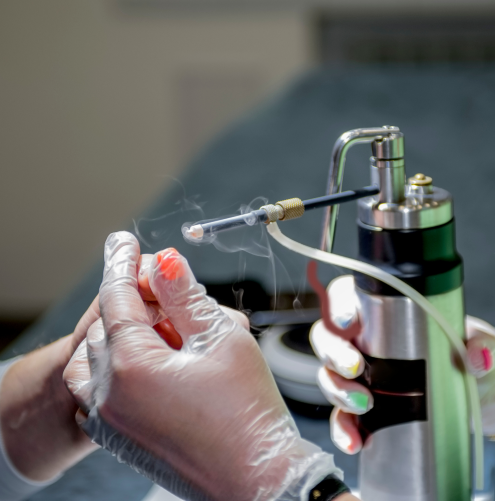
Conditions Treated by Cryosurgery
Cryosurgery and cryoablation are advanced cryotherapy techniques healthcare professionals use to target and freeze abnormal tissues and cells such as cancer cells. Performed in a doctor’s office or a hospital, these treatments offer a minimally invasive option for patients, using extreme cold generated from liquid nitrogen or argon gas.
They are highly effective in eliminating diseased cells and tissues with minimal complications, making use of specialized applicators for precise delivery. Cryosurgery is particularly beneficial for external skin conditions and lesions, including:
- Skin cancer
- Skin lesions
- Benign lesions
- Skin tags
- Plantar warts
- Malignant lesions
- Basal cell carcinomas
- Squamous cell carcinomas
- Seborrheic keratosis
These treatments work by applying controlled freeze times to the targeted area, effectively destroying unwanted tissue while minimizing the risk of nerve damage and other complications.
Cryoablation can help treat internal issues, targeting tumors within organs such as the liver, kidney, or prostate. Applying extreme cold directly to the affected tissues reduces pressure on surrounding nerves, offering a less invasive alternative to traditional surgery and potentially lowering the risk of complications.
Emerging research suggests potential benefits in managing conditions like Rheumatoid arthritis, highlighting the versatility of cryotherapy. A 2022 study found a significant reduction in RA pain after whole-body cryotherapy treatment, with 58% of participants reducing or stopping pain medications at the 12-week follow-up mark.
Candidates for Cryosurgery
Candidates for cryosurgery include individuals diagnosed with specific skin conditions (warts, skin tags, certain skin cancers) or with small, localized internal tumors (liver, kidney, prostate) that haven’t responded to conventional treatments. Ideal candidates should be in good overall health, without severe circulatory issues or cold sensitivities.
Effects of Cryosurgery
- Minimal scarring compared to traditional surgical methods due to the non-invasive nature of the procedure
- Short recovery time, with most patients resuming normal activities shortly after treatment
- Temporary redness, swelling, and discomfort in the treated area, which typically resolve within a few days
- In some cases, changes in skin pigmentation at the treatment site
- Reduced risk of infection and bleeding compared to conventional surgery
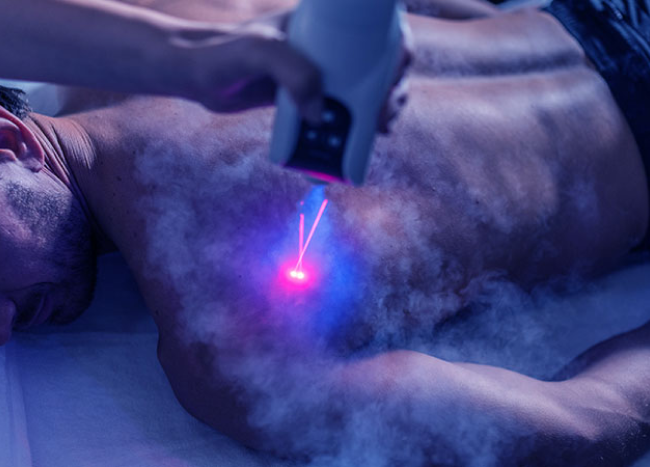
How to Integrate Cryotherapy into Your Wellness Routine
For acute injuries. If you’re dealing with an acute injury, consider daily cryotherapy sessions for the first 2-4 days. This intensive approach helps to rapidly reduce inflammation. As you notice improvement, you can reduce the frequency to 1-3 sessions per week, focusing on sustained recovery and preventing re-injury.
For chronic conditions. For chronic conditions like fibromyalgia, migraines, and arthritis, you may find relief with 2-3 cryotherapy sessions per week. This consistent schedule can help manage symptoms, reduce pain, and improve quality of life over time.
For general wellness. Even if you're not addressing a specific injury or condition, cryotherapy can be a valuable addition to your wellness routine. Schedule 2-3 sessions per week in the cryo chamber to improve wellness, speed up recovery after workouts, boost sleep quality and support mental health.
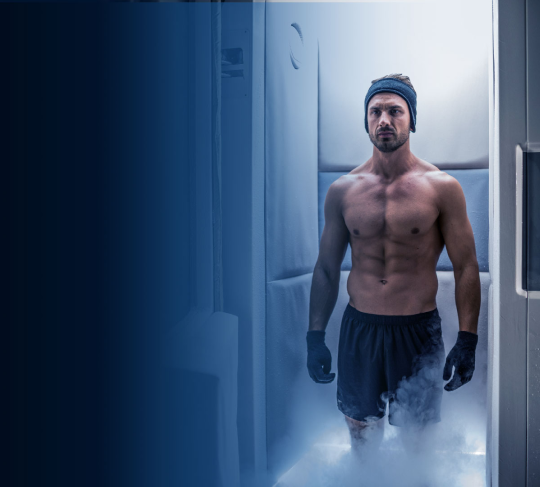
Frequently Asked Questions
Cryotherapy is gaining traction, sparking curiosity and questions for newcomers. Explore our frequently asked questions to help you understand what to expect from this cold treatment before you try it:
Who Should Avoid Cryotherapy?
Cryotherapy offers numerous health benefits, but it’s not suitable for everyone due to the risks associated with extreme cold exposure. If you have any of the following, you should avoid cryotherapy or speak with a healthcare provider to get individual advice:
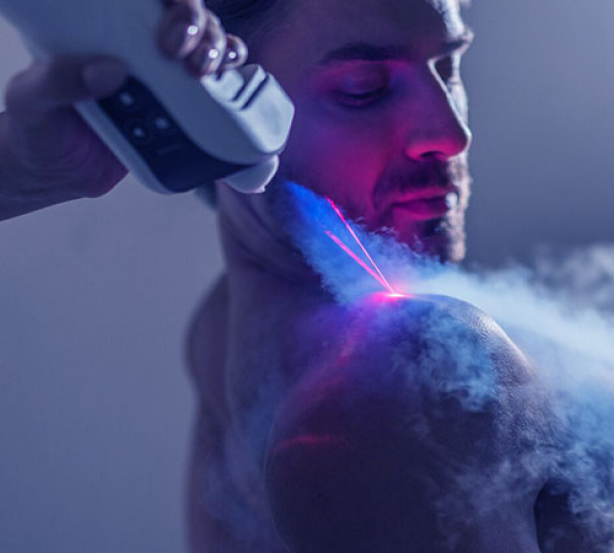
- Cardiovascular conditions such as unstable angina pectoris or a history of stroke
- High blood pressure or severe respiratory issues, where the cold could exacerbate symptoms
- Pregnant women and children, due to the potential risks of extreme cold
- People with severe diabetes or nerve disorders, who might experience adverse effects
- Individuals with specific conditions, including:
-
Raynaud’s disease
-
Extreme cold sensitivity or cold-related diseases (e.g., cold urticaria, cold-induced hemoglobinuria)
-
Severe vascular diseases
-
Hemolysis, trophic disorders, aesthesia disorders
-
Significant anemia or anemia tumors
-
Bleeding disorders
-
Carcinomas
-
Frostbite, tissue microvasculature disorders (such as diabetes), kidney and urinary bladder diseases
-
Paresthesia, neurological diseases, polyneuropathies
-
People with metal implants or pacemakers
-
Are There Any Risks or Side Effects of Cryotherapy?
While cryotherapy is a simple and generally safe procedure when performed correctly by healthcare providers, it has an estimated complication rate of about 0.00225%, making it extremely rare. However, there are potential risks and side effects. These can include frostbite, skin irritation, and temporary numbness or tingling in treated areas. Rarely, individuals may experience an allergic reaction to extreme cold.
Follow all safety instructions and use cryotherapy under the guidance of qualified professionals to minimize risks. If you have sensitive skin or circulatory problems, take extra precautions and stop if you notice unwanted side effects.
What are the Methods of Cryotherapy?
Cryotherapy is administered through several methods, catering to different needs and conditions. Whole-body cryotherapy involves exposure to extremely cold air in a specialized chamber, ideal for overall wellness and recovery.
Localized cryotherapy targets specific areas with cold air or liquid nitrogen, which is perfect for treating skin issues and muscle recovery. Ice baths, another form of cryotherapy, are used for post-exercise recovery, immersing the body in cold water to reduce muscle soreness.
How Long is the Cryotherapy Procedure?
The duration of a cryotherapy procedure varies by type. Whole-body cryotherapy sessions typically last between 2 to 3 minutes, offering quick and efficient exposure to cold temperatures.
Localized cryotherapy treatments can range from a few seconds to several minutes, depending on the specific area and condition being treated.
Ice baths might last anywhere from 10 to 20 minutes, tailored to individual tolerance and recovery needs.
Each method is designed to maximize benefits within a short, manageable timeframe.
What is the Best Cryotherapy?
The “best” cryotherapy method depends on individual goals, conditions, and preferences. Whole-body cryotherapy is ideal if you are seeking overall wellness benefits, like improved recovery and reduced inflammation. Localized cryotherapy is better suited for targeting specific areas, such as muscle injuries or skin conditions.
The most effective cryotherapy is the one that aligns with your personal health objectives and is recommended by a healthcare professional based on your needs.
How Painful is Cryosurgery?
The level of discomfort experienced during cryosurgery varies but is generally considered minimal to moderate. The procedure involves applying extreme cold to the target area, which can cause a sensation of cold, numbness, or a slight burning during and shortly after treatment.
Most patients report these sensations as tolerable, and any discomfort typically subsides quickly as the area numbs. Local anesthesia may be used for more sensitive areas to minimize pain. It is typically viewed as a less painful and effective alternative to traditional surgical method
What Does Cryo Stand For?
Cryo is derived from the Greek word krýos, meaning cold. In medical and therapeutic contexts, cryo refers to the use of extremely low temperatures in treatments, such as cryotherapy for wellness and recovery or cryosurgery for removing abnormal tissues.
Cryotherapy Sessions at ReEnergized
ReEnergized is a leading human optimization studio located in Long Beach, California. We specialize in cutting-edge cryotherapy treatments designed to boost physical wellness and performance.
Offering both local and whole-body cryotherapy, we support a wide range of needs, from athletes seeking accelerated muscle recovery to individuals looking for effective pain relief and inflammation reduction.
Whole-Body Cryotherapy
At ReEnergized, we are committed to personalization and comfort. Our state-of-the-art cryo chamber can reach temperatures as low as -220°F, providing an intense cold therapy experience that promotes numerous health benefits.
The cryo chamber features an adjustable window and temperature control, allowing you to customize the experience to your comfort level and health goals. With multiple protocol options, you can select the treatment plan that best suits your recovery needs.
The chamber also has customizable lighting themes and a Bluetooth sound system, creating a unique and immersive experience that goes beyond traditional cryotherapy.
Localized Cryotherapy
For those with localized concerns, our local cryotherapy targets a specific body part or treatment area, offering a more focused approach to pain and inflammation. This method is beneficial for soothing headaches, improving skin common conditions, and addressing targeted recovery with lower nitrogen consumption, ensuring an efficient and effective treatment.
At ReEnergized, you can expect a holistic approach to wellness, combining the latest in cryotherapy technology with a personalized touch. We also offer the following wellness services to support your health journey:
- Infrared, Blue, & Red Light Therapy. Uses wavelengths of light to promote pain relief, accelerate muscle recovery, increase circulation, and stimulate the release of nitric oxide. Each color penetrates different tissue depths, offering a comprehensive healing and rejuvenation process.
- Hyperbaric Oxygen Therapy (HBOT). Speeds up the body’s natural healing process by inhaling 100% oxygen in a total body chamber, where atmospheric pressure is increased and controlled. It increases blood oxygen levels and energy and stimulates growth factors and stem cells, improving recovery from infections and injuries.
- Sound Therapy. Employs sound waves to facilitate brainwave training, boost ATP production, improve blood flow, enhance oxygen consumption, and improve nutrient delivery to tissues, promoting overall well-being and cognitive function.
- Compression Therapy. Uses controlled pressure to improve blood flow, reduce swelling, and enhance lymphatic drainage, thereby accelerating recovery and providing pain relief. It's ideal for athletes and individuals with circulatory issues.
- Elemental Infusion. Offers hydrogen and mineral-infused water, alongside vitamins, supplements, and nootropics, to optimize body function, boost hydration, and support cognitive performance.
- Performance Testing. Provides advanced diagnostics, including brain scans, Heart Rate Variability (HRV) testing, and analytics to assess human performance. These tests offer insights into your health, wellness, and areas for improvement.
Book a Cryotherapy Session Today for Relief and Better Skin
Discover the transformative power of cryotherapy and start on a journey toward boosted wellness and vitality. At ReEnergized, we offer state-of-the-art cryotherapy services, combining ancient practices with modern scientific research to provide the ultimate recovery experience.
Whether you’re seeking pain relief, improved athletic performance, or simply a boost in overall well-being, our specialized treatments are designed to meet your unique needs. Book your cryotherapy session today, and take the first step towards a healthier, more energetic you.
